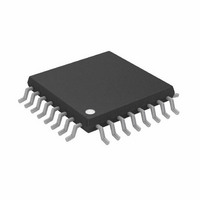AD5763CSUZ Analog Devices Inc, AD5763CSUZ Datasheet - Page 17

AD5763CSUZ
Manufacturer Part Number
AD5763CSUZ
Description
DAC 16BIT DUAL 5V 2LSB 32-TQFP
Manufacturer
Analog Devices Inc
Datasheet
1.AD5763CSUZ.pdf
(28 pages)
Specifications of AD5763CSUZ
Data Interface
Serial
Design Resources
High Accuracy, Bipolar Voltage Output Digital-to-Analog Conversion Using AD5763 (CN0074)
Settling Time
8µs
Number Of Bits
16
Number Of Converters
2
Voltage Supply Source
Dual ±
Power Dissipation (max)
45mW
Operating Temperature
-40°C ~ 105°C
Mounting Type
Surface Mount
Package / Case
32-TQFP, 32-VQFP
Resolution (bits)
16bit
Input Channel Type
Serial
Supply Voltage Range - Analogue
4.75V To 5.25V
Supply Voltage Range - Digital
2.7V To 5.25V
Supply
RoHS Compliant
Lead Free Status / RoHS Status
Lead free / RoHS Compliant
Available stocks
Company
Part Number
Manufacturer
Quantity
Price
Company:
Part Number:
AD5763CSUZ
Manufacturer:
Analog Devices Inc
Quantity:
135
Company:
Part Number:
AD5763CSUZ
Manufacturer:
Analog Devices Inc
Quantity:
10 000
Company:
Part Number:
AD5763CSUZ-REEL7
Manufacturer:
Analog Devices Inc
Quantity:
10 000
Daisy-Chain Operation
For systems that contain several devices, the SDO pin can be
used to daisy-chain multiple devices together. This daisy-chain
mode can be useful in system diagnostics and in reducing the
number of serial interface lines. The first falling edge of SYNC
starts the write cycle. The SCLK is continuously applied to the
input shift register when SYNC is low. If more than 24 clock
pulses are applied, the data ripples out of the shift register and
appears on the SDO line. This data is clocked out on the rising
edge of SCLK and is valid on the falling edge. By connecting the
SDO of the first device to the SDIN input of the next device in
the chain, a multidevice interface is constructed. Each device in
the system requires 24 clock pulses. Therefore, the total number
of clock cycles must equal 24n, where n is the total number of
AD5763 devices in the chain. When the serial transfer to all
devices is complete, SYNC is taken high. This latches the input
data in each device in the daisy chain and prevents any further
data from being clocked into the input shift register. The SCLK
can be a continuous or a gated clock.
A continuous SCLK source can only be used if SYNC is held
low for the correct number of clock cycles. In gated clock mode,
a burst clock containing the exact number of clock cycles must
be used and SYNC must be taken high after the final clock to
latch the data.
Readback Operation
Before a readback operation is initiated, the SDO pin must be
enabled by writing to the function register and clearing the
68HC11
MISO
1
Figure 26. Daisy-Chaining the AD5763
ADDITIONAL PINS OMITTED FOR CLARITY.
MOSI
1
SCK
PC7
PC6
SDIN
SCLK
SYNC
LDAC
SCLK
SYNC
LDAC
SCLK
SYNC
LDAC
AD5763
AD5763
AD5763
SDIN
SDIN
SDO
SDO
SDO
1
1
1
Rev. A | Page 17 of 28
SDO disable bit; this bit is cleared by default. Readback mode
is invoked by setting the R/ W bit to 1 in the serial input register
write. When R/ W is 1, Bit A2 to Bit A0 select the register to be
read in association with Bit REG2, Bit REG1, and Bit REG0.
The remaining data bits in the write sequence are don’t cares.
During the next SPI write, the data appearing on the SDO output
contains the data from the previously addressed register. For a
read of a single register, the NOP command can be used in
clocking out the data from the selected register on SDO. The
readback diagram in Figure 4 shows the readback sequence.
For example, to read back the fine gain register of Channel A
on the AD5763, the following sequence should be implemented:
1.
2.
SIMULTANEOUS UPDATING VIA LDAC
Depending on the status of both SYNC and LDAC , and after
data has been transferred into the input register of the DACs,
there are two ways in which the DAC registers and DAC
outputs can be updated.
Individual DAC Updating
In this mode, LDAC is held low while data is being clocked into
the input shift register. The addressed DAC output is updated
on the rising edge of SYNC .
Simultaneous Updating of All DACs
In this mode, LDAC is held high while data is being clocked
into the input shift register. All DAC outputs are updated by
taking LDAC low any time after SYNC has been taken high.
The update now occurs on the falling edge of LDAC .
Write 0xA0XXXX to the AD5763 input register. This
configures the AD5763 for read mode with the fine gain
register of Channel A selected. Note that all the data bits,
DB15 to DB0, are don’t cares.
Follow this with a second write: 0x00XXXX, which is an
NOP condition. During this write, the data from the fine
gain register is clocked out on the SDO line, that is, data
clocked out contains the data from the fine gain register
in Bit DB5 to Bit DB0.
REFA, REFB
Figure 27. Simplified Serial Interface of Input Loading Circuitry
LDAC
SYNC
SCLK
SDIN
for One DAC Channel
INTERFACE
REGISTER
REGISTER
16-BIT
DAC
INPUT
LOGIC
DAC
I/V AMPLIFIER
OUTPUT
SDO
VOUTx
AD5763













